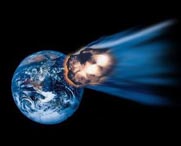Scientists: Asteroid to make close but harmless pass by Earth
A huge asteroid will have a close encounter with Earth this weekend, but astronomers say there is no danger of an impact.

The asteroid, known as 2004 XP14, will whiz by about 269,000 miles (432,821 kilometers) from the Earth, about 1.1 times farther away than the moon.
The ringside seat to the cosmic spectacle will be in North America, where experienced amateur skywatchers with good telescopes should be able see the asteroid as a small moving dot in the sky. Europe can also view the flyby, but the space rock will appear much fainter.
The closest approach will occur on the U.S. West Coast at about 9:25 p.m. PDT Sunday (0425 GMT Monday), but the best viewing time on both coasts will most likely be early Monday, scientists say.
Astronomers know little about the asteroid, which was discovered in 2004. But it is estimated to be as large as a half-mile wide based on its brightness.
More than three dozen asteroids have flown closer to Earth in the last few years, but scientists say 2004 XP14 is one of the largest to zip by.
"For something of this size to come this close is unusual," said Don Yeomans, who heads the Near Earth Object Program at NASA's Jet Propulsion Laboratory.
Yeomans reiterated that the asteroid posed no threat to Earth during the upcoming encounter nor in the next 100 years. Scientists estimate 2004 XP14 will have 10 more close encounters with Earth over this century.
"It's not Earth-threatening," Yeomans said.
Scientists plan to use a giant radar beacon at the Goldstone Observatory in the Mojave Desert to bounce signals off the asteroid as it flies by. The return signal should help scientists determine the asteroid's shape and its future course through space.
As viewed from Earth, 2004 XP14 is expected to cut through the constellations Andromeda, Perseus and Cassiopeia, marked by a 'W' shaped arrangements of stars.
The asteroid will look like a streaking dot against a background of stationary stars, said Roger Sinnott, a senior editor at Sky & Telescope magazine.
"You have to know where to point your telescope because this tiny dot will be gliding by," Sinnott said, reports AP.
O.Ch.
Subscribe to Pravda.Ru Telegram channel, Facebook, RSS!


